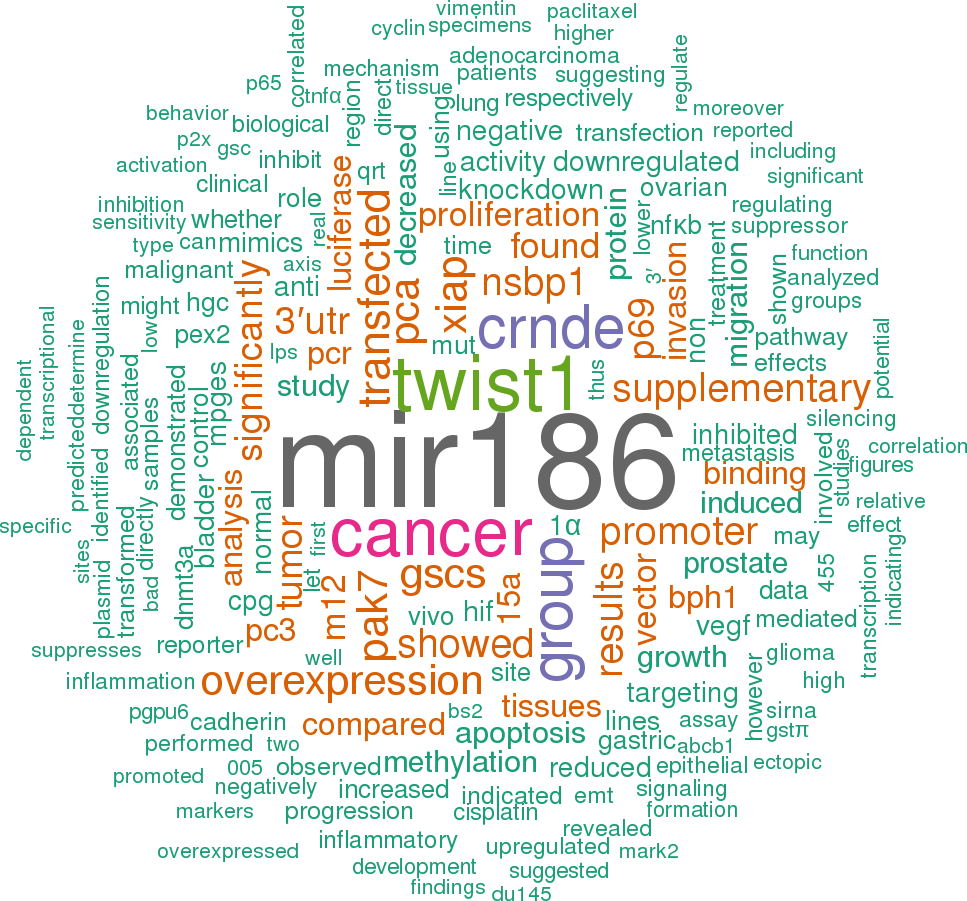Accession
MI0000483
Symbol
HGNC:
MIR186
Description
Homo sapiens
hsa-mir-186 precursor miRNA mir-186
Gene
family?
family?
RF00697;
mir-186
Summary
Caution, this is an AI generated summary based on literature. This may have errors. ?
MIR186 is identified as a microRNA that exhibits a tumor suppressive role in prostate cancer (PCa), with its down-regulation observed in human PCa specimens, particularly in those from metastatic patients, suggesting its function as a metastasis suppressor [PMC8431208]. The expression level of MIR186 is inversely associated with clinical grade and pathological grading in PCa, and lower levels of MIR186 are linked to reduced survival rates among patients [PMC5078081]. While MIR186 has been implicated in the regulation of Twist1 expression and associated with cisplatin resistance in ovarian cancer, its tumor-suppressive effects in PCa are characterized by the inhibition of tumorigenesis and metastasis [PMC5078081]. Additionally, the study found no significant correlation between MIR186 and IL-12 levels, unlike the positive correlation observed between miR25 and IL-12 [PMC9013931]. The regulation of MIR186 expression by the long non-coding RNA (lncRNA) PVT1 has been demonstrated through experiments involving lncRNA PVT1 silenced cholangiocarcinoma (CCA) cell lines, further elucidating the molecular mechanisms controlling MIR186 levels [PMC8286192].
Literature search

92 open access papers mention hsa-mir-186
(771 sentences)
(771 sentences)
Sequence
861928
reads,
2442
reads per million, 157 experiments
ugcuuguaacuuucCAAAGAAUUCUCCUUUUGGGCUuucugguuuuauuuuaaGCCCAAAGGUGAAUUUUUUGGGaaguuugagcu
.(((((.(((((((((((((((((.(((((.((((((..............))))))))))).)))))))))))))))))))))).
.(((((.(((((((((((((((((.(((((.((((((..............))))))))))).)))))))))))))))))))))).
Structure
u u U U ucuggu gcuug aacuuucCAAAGAAUUC CCUUU GGGCUu u ||||| ||||||||||||||||| ||||| |||||| cgagu uugaaGGGUUUUUUAAG GGAAA CCCGaa u u - U - uuuuau
Annotation confidence
High
Do you think this miRNA is real?
Comments
This miRNA sequence is predicted based on homology to a verified miRNA from mouse. Expression of this miRNA was also verified in a human osteoblast sarcoma cell line [1]. The mature sequence shown here represents the most commonly cloned form from large-scale cloning studies [2].
Genome context
chr1: 71067631-71067716 [-]
Disease association
hsa-mir-186 is associated with one or more human diseases in the Human microRNA Disease Database
| Disease | Description | Category | PubMed ID |
|---|
Mature hsa-miR-186-5p
| Accession | MIMAT0000456 |
| Description | Homo sapiens hsa-miR-186-5p mature miRNA |
| Sequence | 15 - CAAAGAAUUCUCCUUUUGGGCU - 36 |
| Evidence |
experimental
cloned [1-3] |
| Database links |



|
| Predicted targets |



|
Mature hsa-miR-186-3p
| Accession | MIMAT0004612 |
| Description | Homo sapiens hsa-miR-186-3p mature miRNA |
| Sequence | 54 - GCCCAAAGGUGAAUUUUUUGGG - 75 |
| Evidence |
experimental
cloned [2] |
| Database links |



|
| Predicted targets |



|
References
|



